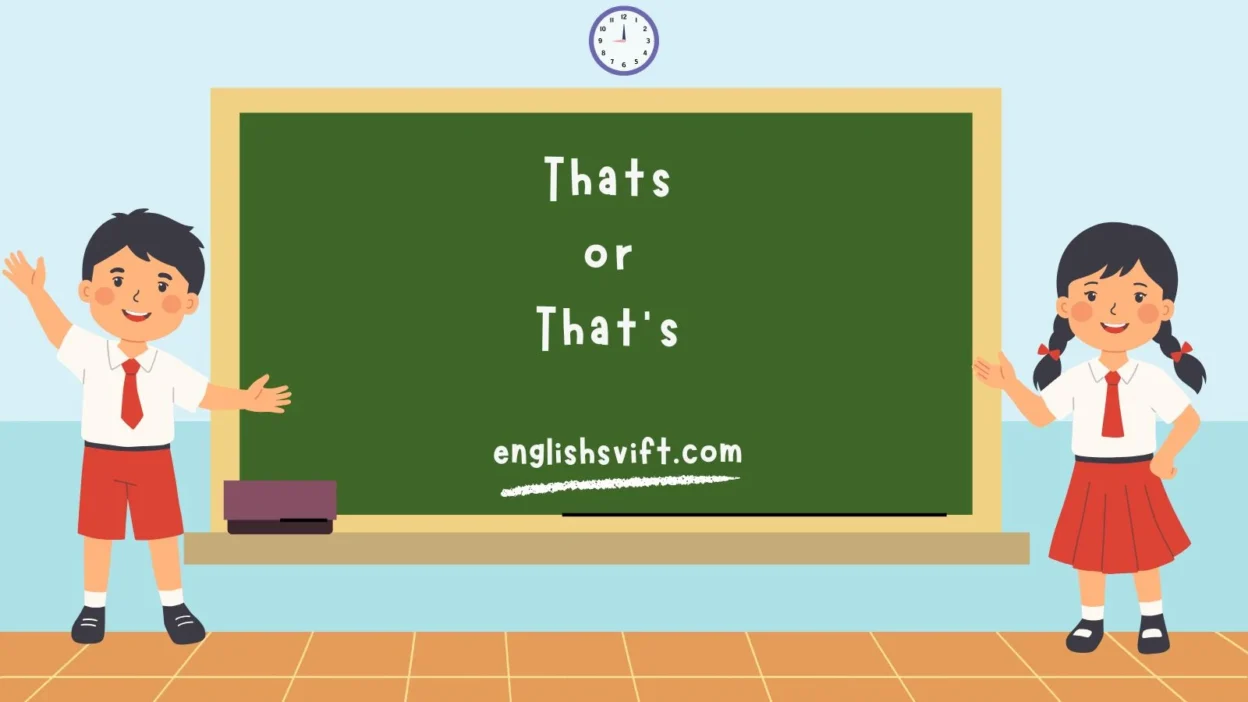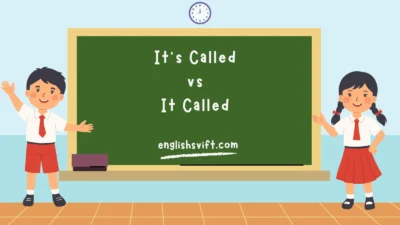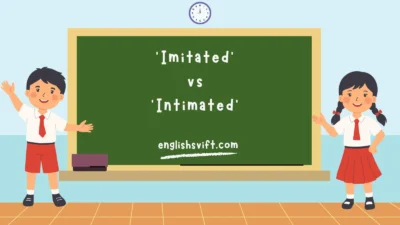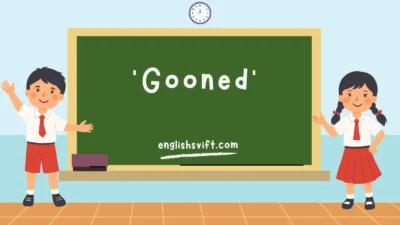Ever found yourself typing “thats” instead of “that’s” and wondering if it’s really wrong? You’re not alone! This tiny mix-up is one of the most common mistakes people make in casual writing, texting, or even professional emails. The difference may look small, but it has a big impact on clarity and professionalism.
In English grammar, “that’s” is a valid contraction of that is or that has, while “thats” is simply incorrect. Yet, thanks to autocorrect errors, fast typing, and casual writing styles, many people mistakenly believe both are interchangeable. The truth is, misusing them can create confusion, misunderstandings, and even hurt your credibility in professional communication.
In fact, the wrong choice can completely change the meaning of your sentence. Whether you’re a student, a content creator, or just someone who wants to improve their grammar, understanding this simple rule will instantly boost your confidence.
Let’s break it down in detail so you’ll never second-guess yourself again when choosing between thats and that’s.
What Does “That’s” Mean in English Grammar?
“That’s” is a contraction, a shortened form created by combining two words. It usually stands for “that is” or “that has”. For example:
- That’s my favorite book. (That is my favorite book.)
- That’s been a challenge. (That has been a challenge.)
Contractions make sentences sound more natural, conversational, and fluent, which is why they’re widely used in spoken English and informal writing.
Why “Thats” Without an Apostrophe Is Incorrect
Simply put, “thats” is not a standard word in English. It lacks the apostrophe, which serves as a marker that letters have been omitted. Writing “thats” is a misspelling and can confuse readers, making your text look unprofessional.
Contractions Explained: “That Is” vs. “That Has”
A lot of learners mistakenly believe “that’s” only means “that is.” But it can also mean “that has” when followed by a past participle:
| Contraction | Expanded Form | Example Sentence |
| That’s | That is | That’s a great idea. |
| That’s | That has | That’s gone too far. |
Common Mix-Up Between “Thats” and “That’s” in Everyday Writing
This error shows up in:
- Texts and chats: quick typing leads to skipped apostrophes.
- Social media posts: casual tone often ignores strict grammar.
- Emails and proposals: where precision matters, this can hurt credibility.
How Autocorrect and Mobile Typing Lead to Errors
Mobile devices sometimes autocorrect correctly and sometimes fail. Fast typing with thumbs, combined with character limits, often results in dropping apostrophes. This is why “thats” appears so frequently in texts.
Possessives vs. Contractions: Why “Its” and “Hers” Differ from “That’s”
People often assume “thats” might mean possession, like “its” or “hers.” But unlike those pronouns, “that’s” is never possessive. You cannot write “thats car” to mean “that car.” The correct form would simply be “that car.”
Real-Life Examples of “That’s” in Sentences
- That’s my favorite song from the 2000s.
- That’s been discussed in detail already.
- That’s not a good idea right now.
Everyday Scenarios Where People Mistakenly Write “Thats”
- Students’ essays: rushed typing in exams or assignments.
- Social captions: “Thats cool!” instead of “That’s cool!”
- Work reports: careless errors that reduce professionalism.
The Role of Apostrophes in English Grammar
Apostrophes indicate either contraction or possession. In “that’s,” it indicates contraction, not ownership. Understanding this distinction prevents confusion.
Formal vs. Casual Writing: When “That’s” Fits and When to Avoid It
In casual contexts like texts, blogs, or conversations, “that’s” works perfectly. But in formal writing (legal documents, research papers), it’s better to use the full forms:
- Instead of That’s been resolved, write That has been resolved.
The Impact of Misusing “Thats” on Clarity and Professionalism
Imagine sending a client proposal with “thats” all over it. It doesn’t just look sloppy—it impacts your credibility. Readers might think you lack attention to detail.
Teachers’ and Editors’ Perspective on the “Thats vs. That’s” Confusion
Educators often stress that grammar accuracy is the cornerstone of effective communication. Editors consider “thats” an avoidable error that should always be corrected.
Contraction Tables: Expanded and Shortened Forms with Examples
| Contraction | Expanded | Example | Correct? |
| That’s | That is | That’s amazing! | ✅ |
| That’s | That has | That’s been a challenge. | ✅ |
| Thats | — | Thats wrong. | ❌ |
Why “That’s” Cannot Be Used as a Possessive Form
Unlike Sarah’s dog or John’s car, “that’s” never indicates ownership. Using it as possessive is a major error.
Misconceptions About Contractions in English
Some learners mistakenly believe contractions are informal shortcuts that shouldn’t be used. In reality, they are a valid part of English, widely used by native speakers in everyday and even professional contexts.
Grammar Rules Simplified: Quick Tests to Check If “That’s” Is Correct
Ask yourself:
- Can I replace “that’s” with “that is” or “that has”?
- If yes, it’s correct. If not, it’s wrong.
Example:
- That’s beautiful. → That is beautiful. ✅
- That’s car is red. → That is car is red. ❌
How to Avoid Typos and Spelling Errors with “That’s”
- Use spellcheck tools like Grammarly or Hemingway Editor.
- Slow down typing when precision is required.
- Proofread before sending important texts, emails, or proposals.
The Evolution of Contractions in English Language History
Contractions have existed for centuries, making speech more fluid. Over time, they’ve become essential in conversational tones and modern content like blogs, captions, and even literature.
Differences in Usage Across Social Media, Emails, and Academic Writing
- Social media: “That’s lit!” feels natural.
- Emails: acceptable in friendly workplace contexts.
- Academic papers: avoid contractions, expand fully.
Proofreading Tips to Correct “Thats” Mistakes Quickly
- Read your text aloud; errors become easier to spot.
- Check for apostrophe placement specifically.
- Keep a mental list of common contractions.
Commonly Misunderstood Contractions in English (I’m, You’re, It’s)
Just like “that’s,” these contractions are often misused:
- It’s vs. Its
- You’re vs. Your
- I’m vs. Im
Fun Memory Tricks to Remember “That’s” Correctly
- Think of the apostrophe as a tiny whisper saying, “I’m replacing missing letters!”
- Mnemonic: That’s = That IS/That HAS
How Misusing “Thats” Affects Credibility in Business Communication
Business professionals know: grammar reflects professionalism. Small errors can affect trust and credibility, especially in client communication.
FAQs
1. Is “thats” ever correct in English?
No, “thats” is not a standard English word. Always use “that’s.”
2. Can “that’s” mean both “that is” and “that has”?
Yes, depending on the context: That’s amazing (that is), That’s been resolved (that has).
3. Why do people mistakenly use “thats”?
Fast typing, autocorrect errors, and casual texting habits cause the mistake.
4. Should I use “that’s” in formal writing?
It’s better to use the full form in formal contexts: that is or that has.
5. What’s the easiest way to test if “that’s” is correct?
Replace it with “that is” or “that has.” If the sentence still makes sense, it’s correct.
Conclusion
The “thats vs. that’s” confusion may seem minor, but it has a major impact on how others perceive your writing. Remember: “that’s” = “that is” or “that has.” There is no valid use for “thats” in standard English. By mastering this tiny detail, you’ll communicate with clarity, confidence, and professionalism—whether in casual chats, social media posts, or formal business proposals.



